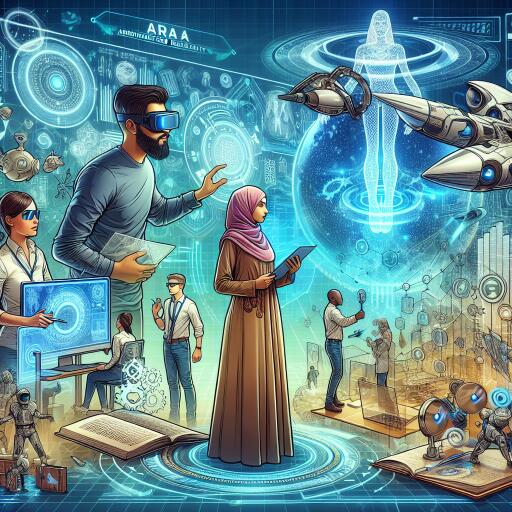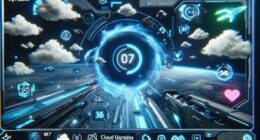“Revolutionizing Collaboration: SARA’s Impact on Augmented Reality Applications”
In today’s rapidly evolving world, where teamwork often feels fragmented, augmented reality (AR) emerges as a beacon of hope for cohesive collaboration. Enter SARA—an innovative platform that is transforming how we connect, communicate, and create collectively. Have you ever grappled with aligning your team’s vision or faced miscommunications during pivotal projects? Such challenges are all too common, but what if there existed a solution to bridge these gaps effortlessly? This article delves into SARA’s utilization of AR to enhance collaboration across diverse industries—ranging from education and engineering to healthcare and design—transforming traditional workflows into dynamic, interactive experiences.
SARA stands for Scalable Augmented Reality Architecture, a platform that fundamentally reshapes collaborative AR by addressing critical challenges in conventional development cycles. It supports various collaboration models while emphasizing component reusability for cross-platform deployment. This architecture is pivotal for enhancing teamwork across sectors like architecture, construction, and gaming, by defining a comprehensive framework comprising visualization, interaction, and orchestration layers within AR applications. SARA empowers effective user engagement through customized collaboration models designed to meet specific project needs.
The correct selection of collaboration models is vital, dictating how users interact with AR elements based on precise project requirements. SARA incorporates multi-user management and session oversight to ensure seamless communication among participants while effectively managing access permissions. Additionally, integrated conflict resolution mechanisms help maintain harmony during collaborative sessions through the Conflict Solver component. Collectively, these features boost productivity and enrich shared experiences in practical scenarios where AR technology can be applied innovatively.
In a case study featuring a voxel-based game prototype, SARA’s potential impact on user experiences within collaborative environments becomes evident. As industries continue to explore novel uses of augmented reality technology through frameworks like SARA, ongoing research focuses on performance enhancements and improving representation issues—ultimately refining user interactions and maximizing the benefits of this groundbreaking technology across diverse domains.
SARA’s collaborative AR architecture enhances user collaboration across a multitude of applications. A key feature is its multi-user management, enabling seamless interactions within shared AR environments, which ensures real-time communication and coordination during joint projects or tasks. Additionally, session management capabilities facilitate smooth transitions between various collaborative sessions without losing context or data.
SARA’s layered architecture supports distinctive visualization, interaction, and orchestration layers tailored for different collaboration models, allowing developers to customize interactions based on specific project needs. Furthermore, the Conflict Solver component is crucial, managing potential conflicts during collaborative activities by harmonizing all users’ inputs. By prioritizing component reusability for cross-platform deployment, SARA enhances productivity, providing consistency across sectors like education, gaming, industrial design, architecture, and construction.
SARA’s collaborative AR architecture finds applications across numerous sectors, bolstering productivity and teamwork. In education, it fosters interactive learning experiences, where students collaborate on projects in real-time, visualizing complex concepts through AR overlays. The gaming industry benefits from SARA by facilitating shared environments that encourage social interaction and competition. Industrial applications include remote maintenance support, where technicians visualize machinery components while collaborating with experts via AR interfaces.
In architecture and construction, SARA allows teams to collaboratively visualize building designs on-site or remotely, improving decision-making processes. Its multi-user session management ensures all stakeholders have simultaneous access to the same information. In healthcare, professionals utilize SARA for surgical training simulations, allowing trainees to practice procedures using augmented models of anatomy.
The reusability of components within SARA promotes cross-platform deployment tailored to specific industry needs. By supporting various collaboration models, like synchronous or asynchronous interactions, SARA enhances communication efficiency among users, regardless of location or device type. This adaptability makes it a valuable tool for organizations seeking to leverage AR technology while addressing unique operational challenges in their respective fields.
SARA revolutionizes teamwork by providing a robust framework for collaborative AR applications. Its architecture supports diverse collaboration models, facilitating seamless user interaction across different platforms. The system’s managed layers promote effective communication and user management, ensuring team members can visualize AR content together in real-time while maintaining appropriate access permissions. The Conflict Solver component addresses discrepancies during collaborative sessions, enhancing overall productivity. By employing SARA, sectors such as education, gaming, and construction experience improved coordination and engagement through shared AR experiences.
Looking ahead, the future of AR and the SARA framework promises significant advancements, especially in enhancing collaborative experiences across various sectors. As industries increasingly adopt AR technologies, we anticipate a rise in sophisticated collaboration models utilizing SARA’s architecture to improve multi-user interactions. The focus will likely shift towards refining conflict management systems in AR applications, ensuring seamless user experiences even during complex collaborative tasks.
Future trends suggest an emphasis on customizable collaboration models tailored to specific industry needs. This adaptability will allow organizations to optimize workflows by integrating real-time data visualization and interaction capabilities into existing processes. With ongoing research into user experience enhancements, such as improved session management and content visualization, SARA is expected to evolve further, leading to innovative applications not only in education and gaming but also in vital fields like healthcare and remote work environments, where effective communication is crucial. These trends promise to enhance productivity significantly through immersive augmented reality solutions powered by SARA.








